Download this ebook in full
To invent, you need a good imagination and a pile of junk.
Thomas Edison
Introduction
A lot of people dream of having a job where their days are spent coming up with new and exciting ideas. This, after all, is the bread and butter of the creative industries. As the digital world has evolved, we’ve seen a growing convergence of digital marketing activities across niches – content marketing, SEO, e-commerce, social media marketing and so forth – with elements of the more traditionally creative activities of advertising and media production.
This convergence means that many more of us now spend our time focusing on generating ‘creative’ ideas. These ideas typically need to translate into assets that produce very specific outcomes, be that press coverage, links, social engagement, leads, or transactions. If you and your business are new to creative content development or have arrived at the task from a more technically-minded background, the prospect of on-cue creativity and regular ideation can be daunting, especially if your performance is measured against the success of your ideas in execution.
In this e-book, I aim to take you through the entire process of how to form ideas, the right ideas: ones that will help you achieve your goals. I’m writing with content marketers in mind, but the process and techniques I explore are equally relevant to anyone who is looking to shape targeted ideas.
Unlike the many brilliant books by leaders in advertising, this volume is not about creative thinking. Rather, it’s a detailed examination of both the strategic and the tactical user-centric approaches to discovering and evolving ideas that are right for your business and audience.

What is ideation, really?
The word ideation makes me wince. Not quite as much as synergy, but enough to have me repeatedly question my flippant decision to write an ebook on the topic.
Why use ideation when you could say the far more everyday brainstorming or coming up with ideas? Is ideation a portmanteau of idea generation? Critiques of jargon point out the role of laziness in the use of obscure language – see for instance ‘Why Jargon Feeds on Lazy Minds’ by Scott Berken, someone who despises ideation and calls out marketers for their deliberately obscure use of language.
Unlike its sister concept brainstorming, invented in 1941 by advertising executive Alex Osborn, the concept of ideation does not have its roots in the age of advertising or modern marketing. This term dates back to 1818 and peaked at the time of Thomas Edison, during the industrial revolution, when new ideas spawned grand new inventions at an extraordinary rate.

While brainstorming has entered the popular language, it is in fact only one facet of ideation. Ideation denotes an entire process of innovation that should not be undervalued.
The best explanation I’ve come across of what ideation is not is from the website of Strategyn, a strategic growth consultancy:
Myths that mislead the ideation process:
There is one belief that permeates academic literature and has influenced nearly all gated product development processes: it is the notion that the innovation process begins with an idea. This is the myth that misleads.
An idea is the output of the innovation process, not the starting point.The innovation process is understood here in terms of forming ideas for a new product or service, but applies equally to determining what shape a new marketing or content campaign should take.
The emphasis on the thinking that occurs before ideas are reached stands against the ‘brainstorm first, verify later’ approach, in which a multitude of ideas are conceived and then filtered down depending on how they measure up against a set of criteria: does it suit the brand? Will it get shared? Will journalists want to write about it?
You don’t brainstorm innovations; you construct them
Strategyn
The one important lesson to take with you when looking to form innovative ideas, especially when it comes to content marketing: Innovation stands the greatest chance of success when the needs of your target audience are at the heart of the process. Ideas are constructed on a foundation of knowing the audience and, in particular, their pain points. This comes back to the fundamental purpose of ideation: problem solving.
Successful problem solving requires a really clear understanding of the problem in context. You can’t reach an effective solution without knowing:
- What the end goal is (objective)
- What’s been tried so far (context)
These two points are central to the strategic thinking behind solving a problem, and are often overlooked at the expense of a campaign or product’s effectiveness. Starting with the ‘Big Idea’ – the strategic steer – not only ensures that your tactical ideas are innovative, but that they work together in a larger ecosystem of output.
We’ll be taking a detailed look at both the strategic and the tactical sides of ideation shortly, but first, what do innovative ideas look like?

Different types of ideas
In their 2004 book Ideation: the Birth and Death of Ideas, Douglas Graham and Thomas T. Bachmann wrote about the taxonomy of innovation. They explore nine different categories of ideas, four of which are particularly relevant to content marketing. These are:
Problem Solution
A problem solution results from trying to solve a particular problem and represents one of the most prevalent and certainly one of the earliest forms of innovation. Problems need to be solved and someone always, eventually, has the ingenuity to solve them.
Problem solution is a core principle of a successful content marketing strategy, which should focus ideas on being useful to your audience. This typically involves creating content that solves a particular problem or satisfies a need. In the context of content marketing, these solutions do not require ingenuity, they simply need to be relevant and well-communicated.
Take this example from Hey Sigmund, which targets parents and solves an important knowledge gap: Phew! It’s Normal. An Age by Age Guide for What to Expect From Kids & Teens – And What They Need From Us

The problem solution is the most important type of idea for brands, whose longevity is made possible through the satisfaction of a user’s need. The following ideas are in this context simply varying approaches to fulfilling such a need.
Evolutionary Idea
The evolutionary idea simply takes something that already exists and improves it.
This is a popular approach in content marketing – especially in the SEO community. You don’t have to be original to produce something of value. Tactics for evolutionary ideas in content include changing the format of an existing piece, going into greater detail, bringing it up-to-date and adding a new perspective.
One popular example of this was Superdrug’s Perceptions of Beauty, which took the idea of comparing beauty ideals across nations first explored by photographer Esther Honig.

Symbiotic idea
A symbiotic idea, which combines two or more existing ideas, can lead to significant breakthroughs.
Similarly to the evolutionary idea, symbiotic ideas in content marketing benefit from pre-existing interest in two or more ideas. This can be a very straightforward approach to developing content ideas. Combining a popular format with a trending theme is one such approach that can have great impact: All the World’s Immigration Visualized in 1 Map.

Artistic Innovation
An artistic innovation is created as an expression of an artistic impulse… Some consider artistic innovation one of the purest forms of innovation because it is creativity free of any practical constraints and has no other use than to give pleasure or, at the very least, an emotional resonance.
This type of idea is what many of us conventionally perceive as real creativity – the creative spark we looked at earlier in relation to idea generation. In content, artistic innovation encompasses digital art, creative storytelling, short film, VR and other experiential products.
A beautiful example, which combines evolutionary innovation with the artistic, is the motion graphic novel The Land of the Magic Flute, a modern and digital adaptation of Mozart’s opera The Magic Flute.


Strategy: discovering the big idea
With an understanding of the types of ideas most pertinent to digital marketers, we return to the importance of the thinking and exploration that should occur before ideas are bounced around.
Whether you’re a product developer, a digital marketer, an engineer or a politician, the ideas you come up with will never exist in a vacuum. Taking the time to understand the environment your ideas will manifest in is, therefore, an important thinking process to undertake before shaping your concepts and campaigns.
- Who do you want to reach?
- Why?
- Where can they be reached?
- What are they doing there?
- What impact do you intend to have on them?
- How?
In marketing, answering these sorts of questions starts with understanding your organisation’s overarching objectives (the core long- and short-term problems to be solved) and any previous efforts to meet them.
What does your company want to achieve?
Start by defining the problem you’ve been assigned, both in isolation and as part of the bigger picture:
- Are you being asked for strategic ideas, or tactical ones?
- What are the metrics you’ve been asked to deliver against?
- What would success look like?
- What’s the overarching business objective?
Ideation for content marketing will require far more instances of ongoing tactical ideation and planning than strategic ones, once the latter has been defined.
Below are three examples which present a simplified overview of how these different parts relate:
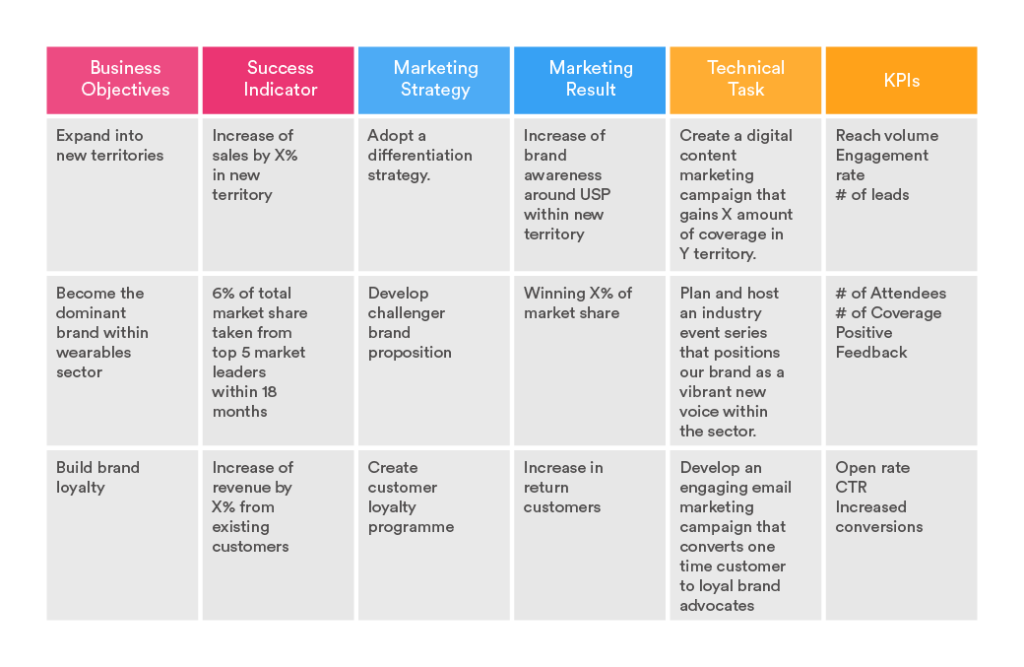
Ideation features across stages of this type of planning, helping us define strategic and tactical ideas alike, as well as develop them into deliverables.
For instance:
Tasked with the business objective of building brand loyalty, a marketing manager will need to apply an understanding of what the company has already done to accomplish this (if anything), what the audience are likely to respond to and what’s sustainable given the resources at hand. While many ideas are likely to be raised and considered, this process finally arrives at the idea to create a customer loyalty programme (strategy). The task now becomes defining what this loyalty programme will look like and how it will be communicated (tactics). With email chosen as an ideal channel, the task then becomes to form ideas for a creative email marketing campaign (tactical) that increases engagement from existing customers.
While the strategies and tactics implemented across businesses vary, they share an extremely important common ground, one that is often obscured by business speak: they all want to motivate people to take action – to share a piece of content, attend an event, buy a product, drink more coffee or call their mum.
This is why user research is critical for ideation and forms part of the discovery process.
Discovery
Discovery is all about taking into account what’s gone before and what the current landscape looks like. The aim is to stop you from:
- Wasting resources on tactics that have proven fruitless
- Continuing down a strategic route that isn’t getting you anywhere
- Barking up the same tree as your competitors, so failing to differentiate
Marketers need a sound understanding of the context in which they’re operating, in order to identify new and overlooked opportunities and to assess the strengths and weaknesses of what they and their competitors are offering.
When it comes to content, a number of different audits can help you to paint a clearer picture of context, which will help you to craft your strategic idea. Here are three areas to explore:
Internal Content audit
Auditing your own content will reveal the popular topics and formats that your audience already find useful and engaging, and the content with the stickiness of water on a duck’s back (the junk). Focus on engagement metrics above reach: Social shares, open rates, downloads, time on page, scroll depth, bounce rate, assisted conversions, clicks and so forth.

Competitor content audit
Which topics and formats have performed well for your competitors? Which have dived? Can you decipher their strategy from their content? How can you differentiate your offering from theirs? What can you learn from them? Using tools like Buzzsumo and Ahrefs Content Explorer can help you compile a dataset for you to learn from, both quantitatively and qualitatively.
Publisher content audit
Your content isn’t just competing with the output of your competitors; you are fighting for eyeballs in an environment full of interesting content from all sorts of sources. Regardless of your niche, there will be either magazines, blogs, news sites, forums or the like talking about the themes and ideas your audience cares about. Find out what these are.

Armed with this information, you’ll already have begun to form a sense of what your audience is interested in, and what they’re not. From there, it’s time to take your user discovery to another level.
What sort of problems do your audience need to solve?
To successfully engage and motivate someone, you need to appeal to their logic or emotions in a meaningful way. This requires you to listen and then respond. It requires an understanding of the person or group’s needs, values and interests. Increasingly, it requires authenticity.
The best products and indeed the best campaigns are those that provide a solution to the needs of a highly targeted audience. When we talk about a person’s needs in this context, we’re talking broadly about wants, requirements and needs. Research indicates that humans have three basic psychological needs:
Autonomy: to make own informed decisions, act according to own values and beliefs.
Competence: to meet challenges successfully.
Relatedness: to feel connected to others.
Your ability to engage and influence people comes down to the extent to which your offering – be that a product, an opinion, a piece of content or a service – appeals to these needs. The fulfilment of our requirements for autonomy, competence and relatedness produces optimism, the holy grail of brand association. What we each need to get to that point varies significantly depending on our distinctive personalities, interests, values and beliefs.
Taking a user-centric approach to your content, your idea must contribute in some way to satisfying at least one of these three. This can be done indirectly. Under the umbrella of satisfying the three core needs are a whole myriad of different wants and prerequisites, such as:
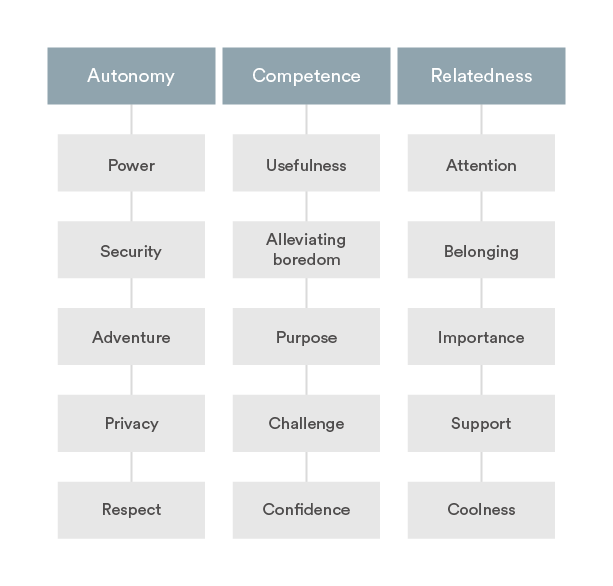
Knowing the needs and wants of your particular audience requires an understanding of who they are, the conversations they are having and their pain points. This is why audience research is so essential.
Audience Research
Target audiences are typically divided into different segments based on their shared interests and values. There are lots of ways you can uncover this sort of information, if your organisation doesn’t already have it documented. Here are just a few:
Social media listening
Social media listening is an immensely powerful means of learning about people’s interests and opinions. There are lots of fancy tools out there for you to track conversations and keywords, but a lot of them cost a pretty penny. I’m personally still mourning the loss of twitter analytics tool Topsy. A simple and free solution that I find useful is keeping dedicated Twitter lists of users or influencers who have demonstrated an interest relevant to your objective and keeping a regular eye on the conversations happening.
Forums
Sites like Reddit and Quora are home to countless communities full of people sharing ideas and content, asking questions that you might be able to answer and that you can learn from. Our Content Discovery Tool scrapes results from the likes of Reddit, and is a quick and easy way of unearthing some of the most prominent questions. A simple site search of either forum can also dig up some great results.
Popular online content
Ahrefs and Buzzsumo are my go-to for exploring and identifying a topic’s most popular content over a set period of time. You can dig into the detail of which social media channels are talking about a topic the most, who’s linking to the content and export the data to play with and unearth trends in stances, formats and subtopics.
Meetups
If you want to get away from your keyboard, go and meet the types of people you’re interested in learning about at organised meetups. Or, if you’re on the shy side, simply explore meetup groups online and make a note of popular upcoming events – a quick and easy way of finding out about hot topics in that community.
Conferences and tradeshows
Similar to investigating meetups, events are a great source of insight, especially for B2B. If you’re developing a platform aimed at digital marketers, go to a marketing conference or tradeshow and hear what they have to say – what are their biggest challenges at the moment? What do they want to achieve in the next couple of years? What are their most common ball-aches? Where are the controversies?
Books and magazines
Just as you could explore popular online content, reading popular books and magazines that target the types of people you want to engage can give you a deeper understanding of the knowledge, language and tone they want and are used to.
Keyword research
What types of questions are people asking about your niche? Longer tail keyword research, especially when broken down into seasonal data, can be an excellent source of insight into the particular knowledge or inspiration an audience is looking for, and when.
Interviews
Speaking directly to people from your target audience is one of the best ways to gather to really understand how they think and what they care about. Aim to speak to at least 15-20 people from across your target audience (5 per segment) for a clear picture. You should start to hear the same things coming up.
Focus groups
Bring people together to share their opinions and thoughts on the topic area of your choice. There are lots of ways other than through market research companies to bring a group of people together for a focus group session. You could reach out to existing customers, your extended network, community volunteers, even posting the opportunity on the likes of gumtree.
To devise a clear picture of your audience, you want to gather as much relevant information about them as they are willing to part with. Consider the following in relation to your audience:
- Basic demographics
- The type of media they enjoy consuming
- Trends in their general interests
- Key challenges in their day-to-day
- Who and what influences them the most
- Communication preferences
- Frustrations
- Ambitions
- Humour
Your research will reveal the sorts of things that the different segments of your audience find useful, entertaining and relevant. It will reveal the general formats and channels they like to be engaged through and you should come away with a sense of their problems and priorities. If you haven’t, keep digging. This understanding is crucial for developing the right ideas and the right content.

‘The Magic Layer’: turning insight into action
The Magic Layer
Armed with knowing the objectives and ultimate endgame your efforts will be contributing towards, the backstory of previous endeavours – both successful and failed – and the personality and needs of your target audience, it’s time to transform your insights into a meaningful positioning for your content, taking into account the needs of both organisation and audience.
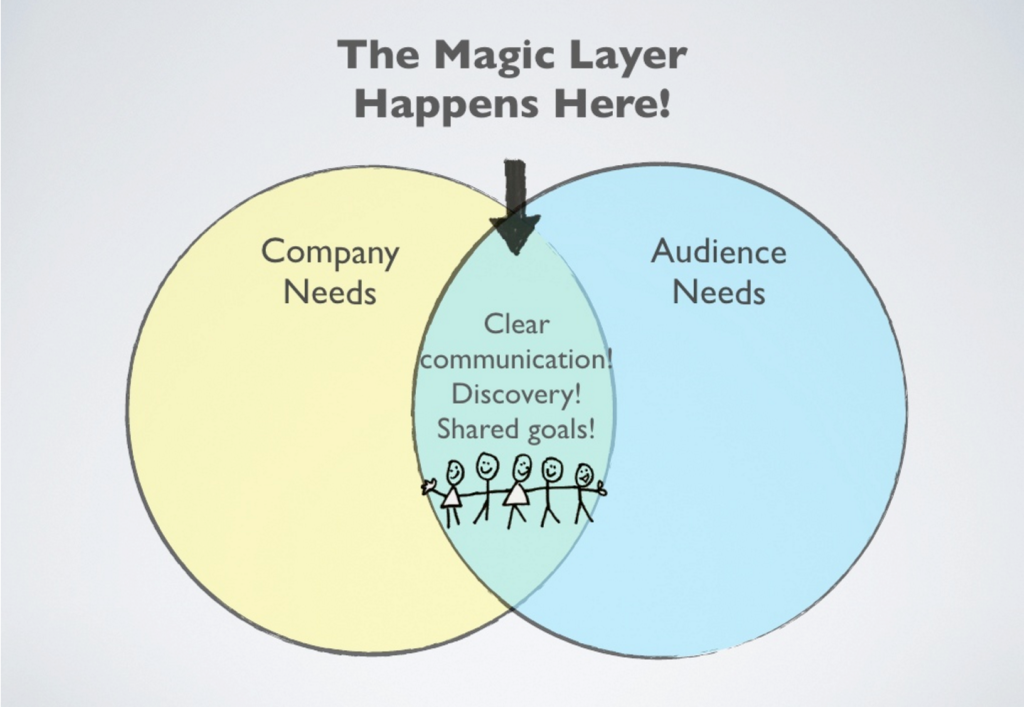
The Magic Layer, by Shelly Bowen, copyright Pybob, LLC. Reproduced with permission.
Critical to the process of turning insight into outputs is getting the right people involved. As Shelly Bowen, who coined the concept of the Magic Layer, also emphasises, reaching ‘the big idea’ is a hugely collaborative endeavour. As well as shaping the most robust big idea, arriving at it as a team helps to ensure buy-in across stakeholders. This is about the ‘Aha!’ moment of uncovering an idea that ticks all of the necessary boxes, including hitherto unmentioned aspects such as feasibility, desirability, resourcing.
The Strategy Statement: The Creative Brief
That big light bulb idea needs to be translated into a clear problem statement that helps to keep your tactical ideation and deliverables in line. For content marketers, this will look something like this:

To apply this to one of our earlier marketing examples:

Tactical Task: What will those events be about?
And a B2B example:
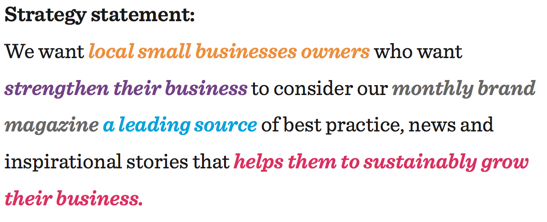
Tactical Task: What goes in the magazine?
These statements essentially form the creative brief for further ideation. With your strategic problem defined and your ideation task plainly set out, it’s time to look at how to turn the big idea into hard and fast ideas for deliverables.

How to produce ideas: tactics & techniques
Now that we’ve determined the strategic direction our ideas need to take, it’s time to look at making them tangible.
Before you bring your teams together and start bouncing ideas around, painting the walls with post-it notes, it’s important to understand one key fact that speaks to the nature of ideas: There is no such thing as originality. All ideas exist in relation to other ideas. Adapting, blending, reinterpreting, repurposing, developing and generally borrowing from other ideas is part and parcel of having ideas. Do not aim for originality. Aim for freshness.
On a practical level, there are lots of different ways you can work on discovering fresh ideas. At Builtvisible, idea generation and development is undertaken according to what’s known as the hybrid group structure. This sees individuals work independently on ideas first and then in a group. Academic research has shown this structure to produce a greater volume and a higher quality of ideas than the team group structure, in which a group works together in the same space and time from the start.
Whether you opt for the former or the latter group structure, what’s important is that you tackle tactical idea generation as a group at some stage in the process, rather than in complete isolation. The people you have in the room can make all the difference to the quality of the ideas produced.
Techniques
We’re probably all familiar with brainstorming as a method for generating a high quantity of ideas, however there are countless other exercises for tackling problems and developing new ideas, both individually and in a group setting. Here’s a selection of 10 techniques and exercises to help you get your problem solving juices flowing:
Storyboarding

Develop a visual story to explain and explore the problem at hand and see where your research informs a given scenario. Physically pinning up quotes, pictures, user info, thoughts and the like can help you see new relationships between different components and ideas. Post-it notes are your friend. Storyboarding can be particularly useful for keeping track of ideas if you’re working over more than one session.
Forced connections

This exercise involves bringing together ideas that serve very different needs or interests to form a new concept. You see this sort of thinking all the time in products like the Apple watch, the Swiss Army knife, smartphones, sofa beds, Trunki ride-on suitcases, and so forth.
To put this method into practice, bring in a bag of random items, or draw up two lists of unrelated items and ask participants to come up with ideas connecting them. This technique can produce some silly results but is a helpful way of getting your team out of a creative rut.
Brainwriting

In this exercise, participants are told to each write down their idea for solving a particular problem on a piece of paper. Each piece of paper is passed on to someone else, who reads it and adds their own ideas to the page. The papers then get passed again on to someone new, who adds to the thread with their ideas. After a certain amount of circulation, the papers can be gathered, ready for discussion.
One advantage of Brainwriting is that it makes sure that everybody is given the opportunity to have their thoughts and ideas thoroughly considered by the group. This avoids the loudest people unintentionally dominating the sessions.
Zero Draft

The Zero Draft is an ideation technique for individuals that is often used by writers and is essentially a form of focused freewriting. Taking your central theme or topic, start by writing down everything you know about the subject, then move on to writing about what you need to know. From there, reflect on why chose this particular topic, or on anything else that takes your fancy. Zero Draft is about getting everything you can think of relating to your topic down on paper (real or digital).
SCAMPER

SCAMPER stands for Substitute, Combine, Adapt, Modify, Put-to-another-use, Eliminate, Reverse. It’s a tool for developing and improving products and services, including content marketing deliverables, through asking questions about existing ones. There are a lot of different questions you can ask for each letter of the mnemonic. A good starting point is to talk through the features of the idea at hand, taking on each of the letters: What would happen if we [substituted/combined/adapted/modified/put-to-another-use/eliminated/reversed] this?
Questioning assumptions

We all carry assumptions with us – assumptions about what is and isn’t possible, about what people want, what will work. This exercise forces us to challenge these and put everything on the table. Draw up a list of all the assumptions you can think of – true or not – and discuss the list as a group, questioning each one. Doing this at various stages in your campaign development can spark fresh ideas, as well as identify knowledge gaps.
Wishing

Let imaginations run wild with this technique, which asks participants to dream up the most unattainable, extreme and impractical solutions they can think of. Create a list of a few dozen wishes pertaining to the task at hand. Focusing on a selection of wishes, consider and discuss the ideas in detail, with the aim of triggering new but more realistic concepts to pursue. What makes them so impossible? How can that idea be scaled down? Which features of that wish could we integrate into this other approach?
Alter Ego / Heroes

This is a fun exercise where small groups imagine how they would go about solving a given problem if their team were led by a famous character, fictional or real. How would Catwoman go about positioning your brand as a thought leader in virtual reality? What would Nelson Mandela do to improve your latest communications package? How would Donald Trump get your core messages across to millennials? You can either chose someone you think embodies the right qualities for the job to help develop your vision, or someone at the opposite end of that scale, to explore less conventional ideas.
Group sketching

You don’t have to be an artist or a designer to benefit from sketching. Visual thinking can help to trigger and develop ideas that discussion and writing leave unturned. Similar to brain writing, group sketching involves participants building on each other’s ideas. To start with, each member will sketch an image that is related in a central way to a concept, idea or topic. Each sketch is then passed to someone else, who sketches another related image on the same piece of paper. This is repeated multiple times around the group. The final images are then reviewed and discussed with the aim of discovering connections that individuals hadn’t spotted on their own.
Six Thinking Hats:
There is a whole host of problem solving exercises and tools that help participants to put themselves into the shoes of another. This particular tool was invented by Edward de Bono and breaks thinking into six different ‘hats’:
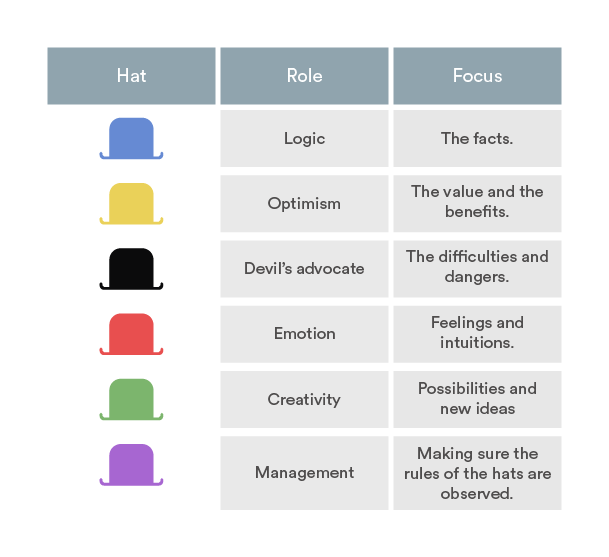
Alternating ‘hats’ as we explore potential solutions encourages us to consider a problem from various angles in a very focused and mindful way.
Selecting the Right Ideas
These above tools and techniques will help you to build a collection of ideas, some more useful than others. All of your ideas should have been guided by your creative brief, and consequently fit within the overarching strategy. Park any ideas that do not. You should still have more ideas than you can action, and likely ones of varying quality.
What next?
Selecting the right ideas from your list depends on whether you have a clear set of criteria to assess each one against. To do this we need to refer back to what we know about our audience, and what we want to achieve with a given campaign.
The audience criteria
Where does your tactical objective fit across the buyer journey? How can you appeal to your audience’s needs at the stage? How does this affect the ideas you should choose? Take a look below at the types of content that suit the different stages of a person’s relationship with your brand and the core methods of engagement at each one. Which apply to the task you’re tackling?

Each of the methods of engagement featured above relate in one way or another to people’s need to feel competent, connected to others and autonomous.
For B2B content producers, the area of psychological need that’s most relevant and easily satisfied is competency, whether that’s through alleviating boredom, instilling confidence or enabling a person to feel useful to others after discovering new knowledge or ideas.
The internal criteria
In addition to assessing your ideas against audience needs, you also want to consider them against your brand guidelines and the wider marketing outcome you’re looking for to solve your business problem.
Let’s consider one of our example statements from earlier:
We want health-conscious millennials living busy lives to view our brand as a vibrant voice within wearables by hosting a series of events that empowers them to take control of their fitness and wellbeing.
The highlighted section of the statement is the strategic outcome which our ideas need to produce in order for your brand to see an increase in market share – the overarching marketing results your business, in this example, is looking for. Strong ideas will clearly align to this.
Rating your ideas
There are different tools available to help you successfully vet your ideas and identify the most relevant and poised for success. Below is a simple matrix we’ve created to help you weigh up the strength of your ideas based on their alignment with your audience needs and internal objectives:
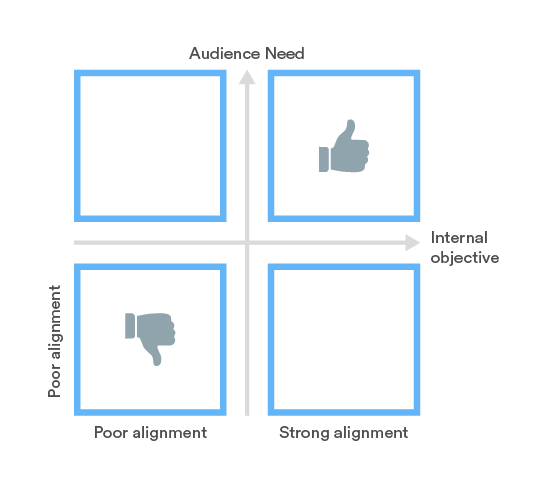
The X axis plots alignment with your internal objectives, while the Y axis reflects alignment with the needs of the target audience.
Which of your ideas fall comfortably within the top right square of this matrix? These are ready to go!
Which ideas fall into the first and fourth quadrant? Can you adapt these ideas in a way that nudges them into the top right?
You should end up with a clean set of strategically validated ideas ready to work with. But alas, your ideation is not yet done.

Idea execution: rules of success
Fleshing out your ideas and determining exactly how you’re going to execute them is the final stage of ideation. While it’s important to protect the integrity of your idea and its alignment with your audience, brand and objective, there are some trends across successful ideas that you should try to cater towards when working out the finer details of its implementation.
Ideas that spread
There’s a lot of literature out there about what does and doesn’t work when it comes to new ideas, especially in the fields of advertising and marketing. Much of that insight can be adapted and applied to content marketing. Here are three of my favourites:
1. STEPPS
In Contagious: Why Things Catch On, Jonah Berger introduces the STEPPS mnemonic for creating ideas and products that spread. Here’s a look at how this can be applied to content marketing:
Social currency: People respond to things that they believe will improve their social status. Make your content and those who talk about it appear remarkable.
Triggers: Stay at the top of your audience’s mind by associating your content with features in people’s everyday lives.
Emotion: Emotions dominate a lot of our decision making. Content that taps into what an audience cares about, or that evokes awe are noted tactics for inspiring audiences.
Public: We’re mostly all copycats at heart. The more visible your messages are, the more likely they are to be adopted. Proactively seek coverage and shares.
Practical value: One of the most important mantras in creating excellent content is to be useful. This doesn’t mean all of your content needs to be instructional. Alleviating boredom by entertaining your audience is plenty useful.
Stories: Brands have finally caught on to the power of storytelling. Make your content human through the use of engaging and authentic narratives. We’ll look at this again below.
2. The Three Rules of ‘Tipping’
Malcolm Gladwell’s The Tipping Point identified three rules an idea must satisfy in order to ‘tip’ into the mainstream. These too can be applied to content marketing.
The Law of the Few
Gladwell describes three types of people with individual gifts that are central to the successful spreading and adoption of an idea. This is more a tactic for the distribution of deliverables than forming ideas, but worth nothing. These are the key influencers you want to engage with your content:
Connectors are people with vast networks of friends and acquaintances across different tribes and circles, becoming the link between different communities through their habit of making introductions.
Mavens are always in the know. They absorb knowledge like a sponge and are both willing and able to share it effectively with others. With a love of solving other people’s problems, this is the type of influencer who, according to Gladwell, start “word-of-mouth epidemics”.
Salesmen are the charmers of the influencer world. They have the power and charisma to persuade people – the very characteristics that make for an effective thought leader.
The Stickiness Factor
Perhaps the most obscure of the rules, the stickiness factor refers to there being particular ways of making a message memorable. Gladwell presents no concrete rules here (the Heath brothers have a strong idea, which we’ll look at shortly), but rather the need to study how an audience engages with your output and to test and iterate on your ideas while closely monitoring the results. This is exactly how you should go about refining your content strategies and execution.
The Power of Context
Marketers are increasingly acknowledging that context is king. Context is everything. We are all extremely sensitive to our environments, and our reactions to ideas – be they in the shape of products or messages – are hugely affected by the conditions of the time and place. Getting your content and its message in the right place at the right time can make all the difference. To understand quite how powerful this can be, just recall Oreo’s legendary tweet during the Super Bowl power outage in 2013:

3. SUCCESS
Finally, I’d be doing you a disservice if I did not include Chip and Dan Heath’s Made to Stick: Why Some Ideas Survive and Others Die. The brothers introduce their own mnemonic, detailing the characteristics that can help make an idea sticky. You’ll notice a level of crossover with factors we’ve already looked at, plus some important new ones that are key for successful content execution:
Simple: In the spirit of Orwell’s decree to a) stick to everyday English, b) “never use a long word when a short one will do” and c) cut out any words you can do without, keeping things simple is a matter of best practice. The Heaths emphasise the importance of identifying and clearly communicating the core message of your idea – something both concise and profound.
Unexpected: Use the unexpected to capture the attention of your audience, but avoid gimmicks. Surprise and awe are the central emotions you’re after. The unexpected can be delivered in countless ways, such as through using the curiosity gap, debunking myths, revealing astonishing feats or uncovering little known origin stories of everyday things.
Concrete: Concrete messaging paints a picture. It uses sensory and direct language to create a tangible and lasting idea in people’s minds. Abstract messaging, the opposite of concrete, is vague and imprecise, making it harder for people to visualise and remember. To compare:
- Abstract: Our program will help make you stronger.
- Concrete: Our program will help you perform 100 push-ups.
Credible: Your ideas need to be seen as credible to be taken seriously. You can achieve this through using stats and facts, influencers and other authorities, or you can encourage people to test an idea out for themselves to verify its credibility.
Emotional: Again, emotion plays a big role in getting people to take an interest in your idea. You need to make people care about what you have to say, which is about making your idea human and relatable. Appeal to people’s identity or self-interest. Encourage them to associate your idea with something they already care about. Nostalgia also works brilliantly.
Stories: Both Berger and the Heaths recognise the importance of storytelling. Advertising veteran Hegarty writes: “If the idea is the foundation of the creative process, then the story is the vehicle that delivers it, making it memorable and provocative”. Keep asking yourself: what’s the story here? Are we communicating it clearly?
Validating your deliverables for success: A checklist
We’ve repurposed a number of the trends in the rules and mnemonics detailed above into a handy checklist that will help you to execute your ideas in a way most primed for success:
Don’t worry if you can’t tick every box, as long as your ‘yes’s outnumber the ‘no’s, then you’ll know that you’ve done what you can to give the idea its best chance.

Final note
And there you have it. There are no guarantees and no rules for success when it comes to ideas and innovation, just a lot of guidelines for steering your efforts in the right direction. Whether you’re at the strategic stage or refining your deliverables, there’s one question you should keep asking from the very start of your journey:
Why?
Why are we doing this?
Why would journalists want this?
Why is this or that the way it is?
Why is this the right way to solve that problem?
Why will this resonate with that audience?
And so on.
Asking why forces you to question and explore the many angles of the problem at hand. This, in turn, will help you at all stages on the path of discovery to the very best ideas, the ones that can change your business, the lives of your audience, and, for the really profound, perhaps even the world.
References
Gagne, M. (2014). The Oxford Handbook of Work Engagement Motivation and Self-determination. Oxford University Press, New York.
Sagor, R. “Motivating Students and Teachers in an Era of Standards”. ASCD.org. Available: https://www.ascd.org/publications/books/103009/chapters/Identifying-Our-Basic-Psychological-Needs.aspx
Bowen, S. “What is “The Magic Layer” of content strategy?”. Pybop.com. Available: https://pybop.com/2012/05/the-magic-layer-confab-2012-content-strategy/
Girotra, K, Christian Terwiesch and Karl T. Ulrich, (2010). “Idea Generation and the Quality of the Best Idea”. Management Science. Vol. 56, No. 4 pp. 591-605. Available: https://www.jstor.org/stable/27784139
Berger, J, (2013). Contagious: Why Things Catch On. Social Dynamics Group, LLC, New York.
Gladwell, M, (2002). The Tipping Point: How Little Things Can Make a Big Difference. Little, Brown and Company, US.
Heath, C and Dan Heath, (2007). Made to Stick: Why some ideas take hold and others come unstuck. Random House Books, London.
